Pipe Dreams: The In’s & Out’s Of Aquarium Plumbing
By Alex Vasquez and Kevin Schweer
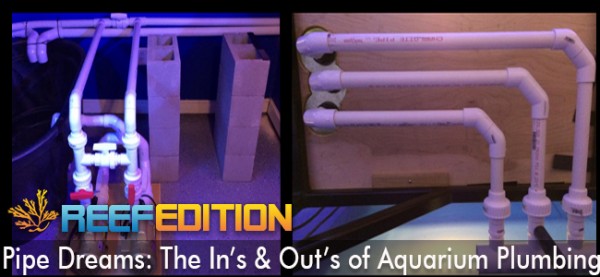
You have a lot of options now-a-days when it comes to plumbing an aquarium and that can make the task a bit overwhelming. There are quite a few different solvents, glues, primers, fittings, piping, and sealants all with their own particular purpose. To complicate that a little more each one has its advantages and disadvantages for applications in our aquarium builds. In this article, we will attempt cover some of the different types of plumbing needs you will face, as well as the tips and tricks to assist in making plumbing decisions a bit easier.
Tools:
- Hacksaw
- Painters tape (more on this in later)
- Black marker or sharpie
- Ratchet action PVC pipe cutter (well worth the small investment)
- Measuring tape
- Miter saw (this is more of a nice to have)
- Pliers (two if you have them)
- Rubber hammer
Let’s face it, you’re going to need tools at some point. The list above is basic for the most part. A hand operated hacksaw will make quick work of cutting a section of PVC; however, the ends will need to be cleaned up, and you might not always get a flush cut. Why do you need a flush cut? It’s simple really. It maximizes the contact space and allows for proper seating of slip-on fittings. Wrapping the PVC at the location you need to cut with painters tape is a trick I use to give me a “straight” 360° guide line around the PVC when using a hacksaw.
If you want a less manual way of cutting PVC, first measure the sections and mark it (fine point sharpie is best), then a Ratchet Action PVC Pipe Cutter makes quick work of it (proper placement is needed to ensure a flush cut).
Now let’s say you have a really big plumbing job…your friend and time-saver is—and always will be—a miter saw. It’s going to all but guarantee you a flush cut each and every time—the bonus being that the ends will be nice and clean and ready for “dry-fitting”…Did he just say dry-fitting? Yes, I did! I dry fit everything. You might be asking yourself “why dry fit?” …and the answer will come the first time you have to redo a section completely because it was too short, or too long, or it leaks…then you will understand why you should dry fit. I will be the first to admit that dry fitting is a pain. You’ll need a set of channel locks pliers to pull fittings apart and sometime a rubber hammer for the overly stubborn pieces, but the end result is more than worth it.
Piping:
- Vinyl Tubing
- Breaded Vinyl Tubing
- schedule 20, 40 and 80 PVC
- flex PVC
When it comes to plumbing your aquarium, there are different types of piping you can choose from.
Vinyl Tubing
Vinyl tubing is a soft and very flexible tubing for plumbing your tank. It comes in many colors, but the 2 most common are clear and black. Vinyl is very easy to work with and very easy to cut. Usually, vinyl is the easier way to plumb your tank, but there are downsides such as kinking, hardening over time, and unsightly buildup on the inside (when using clear). Connections for vinyl pipe are usually barbed fittings.
Flexible PVC
PVC stands for polyvinyl chloride. It’s a very good choice for plumbing our aquariums. It holds up very well and there are countless fittings for just about any need you may have. Fittings for flexible PVC require a solvent glue to hold them together. When done correctly, the bond between fitting and pipe is very strong and leak-proof. Benefits of flexible PVC include the ability to bend it around objects and make sweeping turns instead of direct 90° turns with rigid PVC along with its vibration absorbing guano ties. A recent product is now out called “superflex” PVC which is the same as the flex PVC but much more flexible.
Rigid PVC
Rigid PVC is made from the same polyvinyl chloride as the flex PVC above. This is the type of pipe you will find in many home plumbing systems. It comes in different “strengths” for lack of a better term known as schedules. There is schedule 20, 40, and 80. 20 being the “weakest” with the thinnest walls and 80 the strongest with the thickest walls. Like flex PVC the rigid PVC is solvent welded at joints of the fittings. With rigid PVC you can get a nice clean look to your plumbing, with the availability of so many fittings the possibilities are endless. One negative about the rigid PVC is that it is…well…rigid, which can limit you a little and make you use more fitting than you may need with flex PVC.
Fittings:
You have an overabundance of available fittings, 90° & 45° elbows, 90° & 45° street-T, standard 3 & 4-way Tee’s, caps, couplers, unions, and the list goes on and on. These type of fittings are normally all considered “rigid” PVC and come in schedule 40, and 80 in slip x slip, slip x thread, and thread x thread. The slip type is meant to be primed and glued together, while the threaded type is meant to be used with pipe thread sealant and (contrary to popular belief) NOT Teflon Tape! The key with pipe thread sealant is to note that it reads for “potable” drinking water. Back to fittings, I personally make every attempt to stay away from 90° elbows when I need to change the direction or the path the water needs to take, this means a little more cutting and gluing but aids the flow of water in the corners reducing back pressure. I like 45° PVC Street elbows instead in the corners.
One thing I notice on a lot of builds is the lack of unions and ball valves. The reason I like them is that they are helpful for disassembly and to cut off water in whatever direction you might need to. Unions in particular are a fitting that I think are underused. If you need to remove a section of PVC (clogged with snails, sand, or some obstruction) and don’t have a union/s, your only course of action is to cut it out and glue a coupler to reattach the sections together. One more thing on ball valves, cheap ones are “ok,” but they can be very hard to turn and even more so when the inner workings have calcium deposits coating them. I prefer Cepex ball valves for a few reasons: 1) they are durable, 2) they are adjustable, and 3) come with both slip and thread interchange ends.
Like ball valves, gate valves have a similar function (cutting off the water), but gates allow you to more precisely turn the flow down or up. They have an internal wall (gate) that moves up and down as opposed to a ball that spins the water’s flow off. Most skimmers use a gate valve on the output to precisely raise the water level inside the main chamber. Gates are more costly so should be considered only for an application that requires precision flow control.
So what’s a bulkhead? They’re used to create seals on the flat area of a hole that has been cut in an aquarium. Once installed, you can use a threaded connector, slip (glued in place), or a barb connector. Depending on your application, you will either be using standard duty ABS or schedule 80, note that the outside diameter is larger for the SHC 80 ones, so they are not interchangeable. Both bulkheads are for sealing against a flat surface, and while they might work on a slightly curved one, it’s better to use “uniseals” for curved applications like brute trash cans. Pay close attention to the required hole size that will be cut out to ensure a water-tight fit.
Connections:
When connecting your plumbing either to a bulkhead, pump, or to itself, you must make sure to choose the appropriate fittings and connections for the piping you are using. Connections include unions, 90° fittings, 45° fittings, couplings, etc.
Connections for vinyl tubing are also known as barbed fittings or nipples. These are pieces that fit inside of the vinyl tubing and have barbs to hold them in place. Be sure to choose the correctly sized barbed fittings for the vinyl tubing you are using. These should fit snug and may take a little effort to fully insert into the tubing. Take note that you may need to clamp your tubing to make a stronger connection that will not push or fall off. Remember we are dealing with saltwater which does not mix well with metal. It may take a little searching, but they make plastic clamps for vinyl tubing which hold up better and are safer for your tank. These come in many colors with grey and white being most common.
When connecting both flex and rigid PVC, you will need to use PVC fittings. These fittings slide over the outside of the PVC and are glued using PVC glue to hold them to the pipe. Again make sure to use the correct sized fittings for the pipe you are connecting to. These fittings will be tough to slide over the PVC while dry, but will push in pretty easily once you apply the glue to make your final bond. While flex PVC may seem to be able to be connected using barbed fittings like vinyl tubing, it is not meant to be clamped and will more than likely fail and leak.
When connecting your plumbing to pumps and in some cases bulkheads, threaded connections are needed. Most pumps and bulkheads use NPT (national pipe thread) fittings. You will also see abbreviations such as FNPT (female national pipe thread) and MNPT (male national pipe thread). Female threaded fittings have the threads on the inside of the fitting and male threaded fittings have the thread on the outside. Note that when using threaded bulkheads the threads on the outside are not NPT threads and are ONLY for the bulkhead nuts, to thread into a bulk head you will need a male threaded connection.
Tips and Tricks:
- Use a good set of Channel Locks to removed stubborn dry connected fittings.
- Tape a line around the section to be cut will help guide you when using a hand saw.
- Prime, glue, push, twist, and hold for a 5 count.
- 45° cut your drain ends into the sump to aid in reducing back pressure.
Windup:
To say that you have endless ways on how any aquarium can be plumbed is quite true. Each of the methods come with distinctive advantages as well as disadvantages, but the best option might just be a combination of a few different ones to make it work for your particular needs. Sitting down to draw out a sketch will be the single biggest advantage, as it will help you with selecting the right components needed before you get started and can save you a lot of time and money. I dry fit everything (not the most popular way to layout plumbing), but once you have glued something, it’s permanent and cutting it out and redoing it is an even less popular option and why I chose to dry fit. The best part is that when it’s all said and done, and it’s working as you expected it to, your fish, coral, inverts, and nosy neighbors won’t care about the plumbing choices you made.
Welcome to the obsession and happy reefing!
If you’ve got questions about plumbing, or would like to share some of your plumbing knowledge, we’d love to hear from you on the R2R DIY subforum.
Authors
Alex V. (143MPCo), has kept marine and fresh water aquariums since 2006. His current systems are a 150g Mixed Reef that is home to a large variety of coral and reef safe fish, with a recently added 390g basement aquarium that will be SPS dominate. He is a member of MASNA and Reef Squad Leader at Reef2Reef.
Kevin (kschweer), has been keeping aquariums of all types for the better part of his life. It all started with a 120g freshwater tank complete with an under gravel filter set up by his father for him and his brother. Fast forward to 2009; he took the jump into saltwater and hasn’t looked back. Currently, he has a 57g rimless and a 30g Frag tank. Kevin is on the board of directors for his local reef club (New Jersey Reefers) and also a leader for the Reef Squad on the greatest aquarium forum, Reef2Reef.

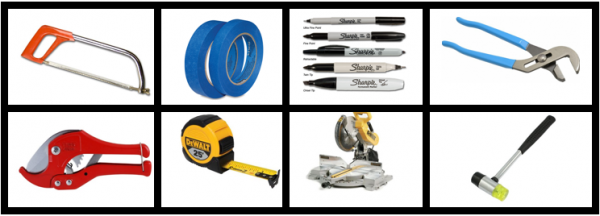
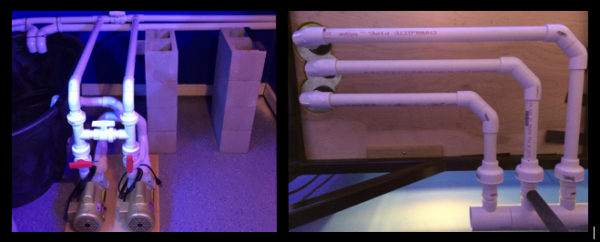
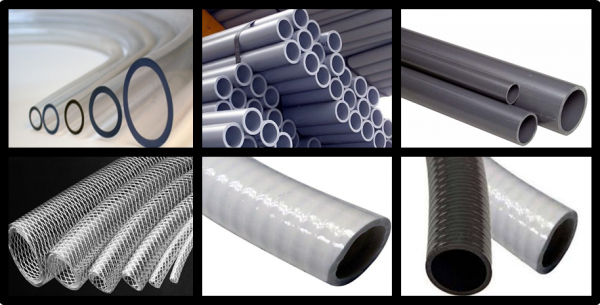


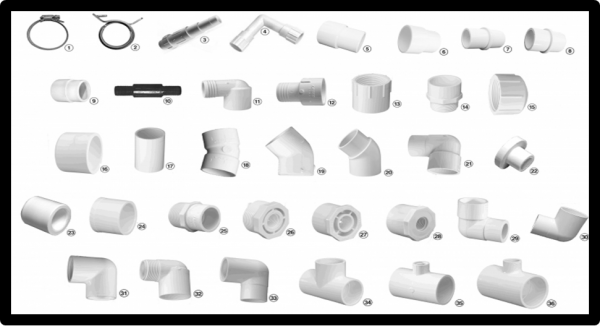
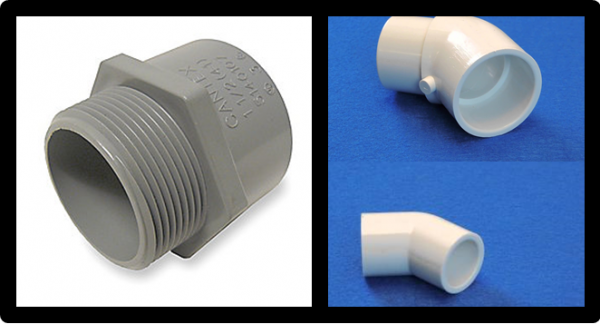
Leave a Reply
You must be logged in to post a comment.